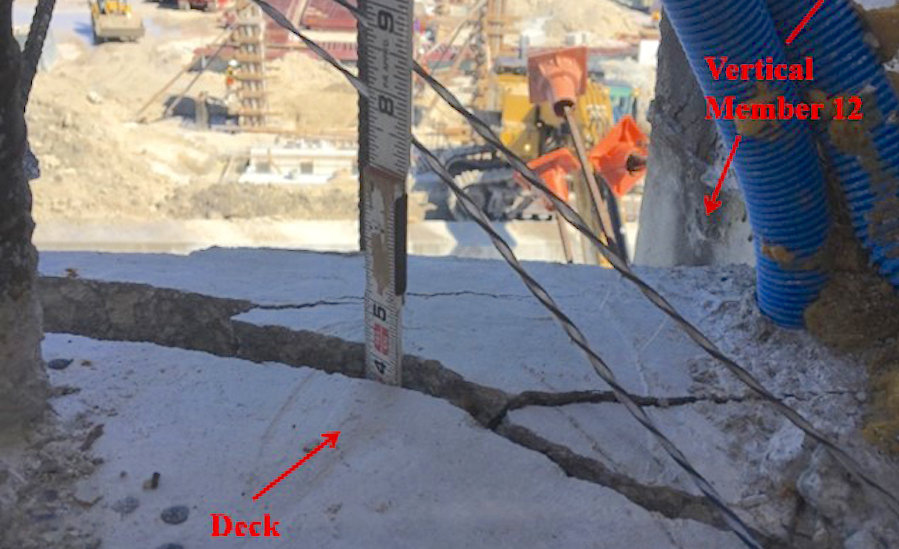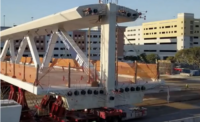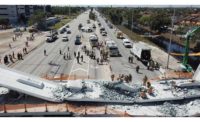The Florida International University Tragedy
Berger: FIGG Is Slow To Hand Over All Bridge Collapse Data
This story updates and corrects the Oct. 7 print edition version

One of the photos provided from the Dept. of Labor's investigation of the March 15, 2018 collapse of the pedestrian bridge at Florida International University.
Editor's note: This story updates and corrects the Oct. 7 ENR print edition version, where FIGG's name was inserted in a paragraph in error and the company's statement was incorrectly reported in part.
About half an hour before the almost-completed pedestrian bridge collapsed onto a busy Miami-area road last year, killing six people, Denney Pate, the bridge’s engineer-of-record, sent a text to Linda Figg, the chief executive of FIGG Bridge Engineers.
In the text Pate reported on a meeting that morning with other project team members. He reassured Figg that the “meeting went pretty well” and that FIGG would come up with ideas to “better the current situation” related to cracks at the structure’s north end, where final connections had not yet been made.
The words of that text were recited in Florida state court in Miami in June as part of an ongoing argument between FIGG and one of its co-defendants, Louis Berger Group, in the 18 lawsuits filed against the project team members and Florida International University. A Berger Group attorney, Hariklia Karis, read the text while Pate was under oath as a witness in a pre-trial conference called partly to clarify the importance of FIGG providing all project-related text messages. At the hearing Pate testified that his phone sustained damage in a washing machine so that its data could not be recovered.
Judge Jennifer Bailey ordered Figg to turn over the unamended notes from a meeting the day of the fatal Florida bridge collapse—it had earlier supplied ‘corrected’ minutes.
During the past year Berger has tried to pry more and more data and records from FIGG in the legal process known as document production. Of special interest was how Pate’s phone had remained in his possession although attorneys for the company had notified staff that all documents related to the tragedy must be secured. It wasn’t until months later, after the phone had been damaged, that a FIGG board member told Pate it was needed for trial preparation.
The document contest that has raged between FIGG and Louis Berger is recorded in transcripts of the pre-trial conferences recently reviewed by ENR. The clashes dramatize how multilayered electronic communication records further complicate the “E-discovery” process and related matters for parties to civil litigation, including co-defendants. And they are a prime example of how texting and use of mobile phones have added further entangling details.
On Oct. 22, the National Transportation Safety Board will issue its final report on the Miami bridge disaster and the accident’s aftermath will enter a new phase with new pressure to deliver a settlement to victims and families. Previously, NTSB and the U.S. Dept. of Labor have placed most of the blame on FIGG for design errors and failure to recognize and act on the signs of impending collapse.
Berger remains the lone holdout to a settlement. While FIGG is by most accounts so far the project’s most culpable party, it is believed to have a comparatively limited insurance coverage limit of several million dollars. Berger is a much bigger company with an even bigger parent, WSP, which together with its insurers faces a greater potential payout in damages.
Over the past year Berger has sought, with some support in the form of orders by Judge Jennifer Bailey, emails, texts and calculations made on the bridge project. On April 10, for example, Bailey issued an order requiring FIGG to turn over the “log of the handwritten or electronic notes or drafts” used for creation of the corrected meeting minutes from the morning of the tragedy, March 15. Bailey intended to review them privately.
Although Bailey last month ordered the parties to the lawsuits to participate in a mediation, the document production issues remain unsettled.
FIGG: We Met All Document Requests
Berger, through its parent, WSP, declined to comment, citing the pending litigation. FIGG has previously denied responsibility for the collapse and claimed the truth could only be known as more information came out. In a statement, FIGG says that it has “diligently complied with voluminous document requests.”
One still-murky area is how FIGG hired Berger to peer review only the project’s final stage but not its interim phases. The concrete truss, the bridge’s main element, had been cast off site and collapsed several days after being rolled into position over the road and before final connections were made. FIGG, in its statement, implied that Berger was supposed to have provided a peer review of the entire structure and “that there are no exclusions in the scope for analysis of the construction phases.”
That contradicts the findings in the Labor Dept. report on the tragedy, which says that FIGG had hired Berger to perform a peer review of only the final design, excluding the construction phases. The Labor Dept. report, FIGG said in its statement, “is factually inaccurate and incomplete and includes errors and flawed analyses.” The final NTSB investigation, FIGG’s statement said, will be available soon and tell a different story.
Editor's note: This story was corrected on October 2 to fix an erroneously recorded version of the statement from FIGG.




